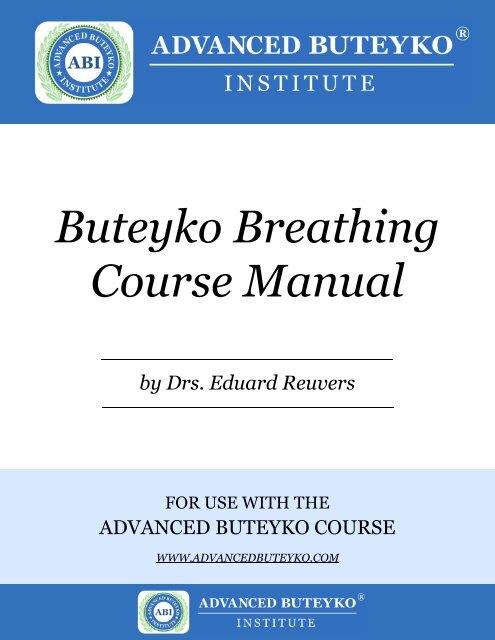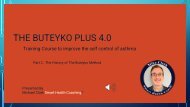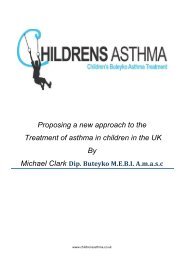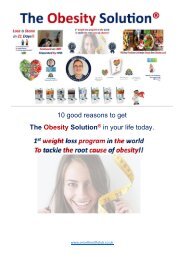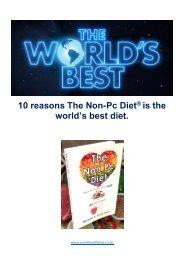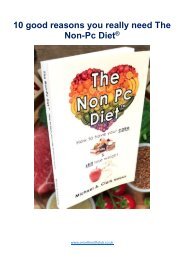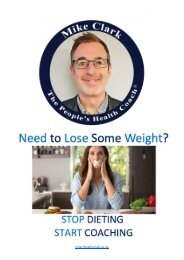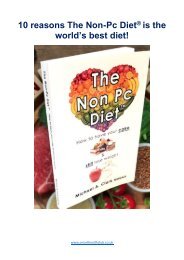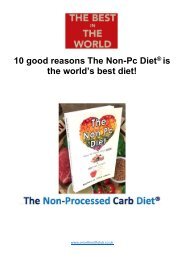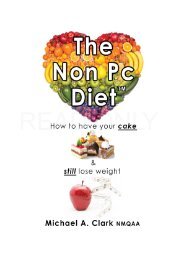Buteyko-Course-Manual
You also want an ePaper? Increase the reach of your titles
YUMPU automatically turns print PDFs into web optimized ePapers that Google loves.
<strong>Buteyko</strong> Breathing<br />
<strong>Course</strong> <strong>Manual</strong><br />
by Drs. Eduard Reuvers<br />
FOR USE WITH THE<br />
ADVANCED BUTEYKO COURSE<br />
WWW.ADVANCEDBUTEYKO.COM
<strong>Buteyko</strong> Breathing <strong>Course</strong> <strong>Manual</strong><br />
Copyright 2019 by Drs. Eduard J.A. Reuvers<br />
All rights reserved.
Foreword<br />
This <strong>Buteyko</strong> <strong>Course</strong> <strong>Manual</strong> will help you prepare for the <strong>Buteyko</strong> Breathing<br />
course, and give you a better idea of what the course is about. Please read this<br />
manual before starting the course, or on the very first day of the course. It<br />
contains important information to help you get started in the best possible way.<br />
May 2019<br />
Drs. Eduard Reuvers,<br />
Advanced <strong>Buteyko</strong> Institute<br />
www.advancedbuteyko.com/eduard<br />
1
1. About the <strong>Buteyko</strong> <strong>Course</strong><br />
The complete <strong>Buteyko</strong> Breathing course consists of seven personal teaching<br />
sessions with a <strong>Buteyko</strong> instructor over a period of 4 to 6 weeks. The course is<br />
structured according to the principle of gradual training. Before each teaching<br />
session you’ll be given some homework to do to prepare for the session. Then<br />
during the teaching session you’ll meet with your instructor in person or via a<br />
video calling app (Skype, Facetime or Whatsapp) to review your practice, solve<br />
any issues and receive additional guidance and instruction to improve your<br />
practice and raise it to a higher level.<br />
Using this gradual teaching system, you’ll start with the most basic versions<br />
of <strong>Buteyko</strong> Breathing and gradually increase your level of skill. We do customize<br />
the approach for each student so not everybody will progress in the same way.<br />
Eventually you’ll arrive at highest levels of <strong>Buteyko</strong> Breathing and be practicing<br />
in a relaxed yet very powerful way, which boosts your practice and brings results<br />
2
more quickly and effectively.<br />
The course is customized depending on the suitability of the various <strong>Buteyko</strong><br />
exercises for each person. After the seven teaching sessions you’ll have learned<br />
how to safely practice <strong>Buteyko</strong> Breathing at a gradually increasing level of skill<br />
and hopefully have achieved a great improvement in your breathing scores and<br />
overall health and a corresponding reduction in chronic disease symptoms.<br />
After the course your <strong>Buteyko</strong> instructor will still be available for regular<br />
ongoing sessions as needed, to help you improve your breathing further or<br />
maintain your progress.<br />
Account Setup<br />
After you’ve finalized your signup for the course, your instructor will make<br />
an account for you to login to the app and website. You’ll receive an automated<br />
signup email from our website system when your account is made. This signup<br />
email contains your account email and password. When you have your login<br />
details, please:<br />
1) Download and login to the Advanced <strong>Buteyko</strong> app. You can get the app at<br />
www.advancedbuteyko.com/app.<br />
2) Fill in the online <strong>Buteyko</strong> form using the link in the signup email.<br />
Alternatively you can use this public link: www.advancedbuteyko.com/<br />
form but do make sure to fill in your account email address correctly.<br />
Preparation for the First Teaching Session<br />
A convenient time will be arranged to meet with your instructor for your first<br />
teaching session, either individually or in a group setting, on location or via<br />
Skype, Facetime or Whatsapp video.<br />
To prepare for your first <strong>Buteyko</strong> Breathing teaching session, we suggest you<br />
do level 1 two or three times (using the Advanced <strong>Buteyko</strong> app), then move up to<br />
level 2 and do that a few times also. So when you speak with your instructor, you<br />
will have done some <strong>Buteyko</strong> Breathing sessions already at level 1 and level 2.<br />
3
If level 1 didn’t go too well, it is best to do it a few times more before moving<br />
on to level 2. Only go to level 2 if you feel level 1 went quite allright. When you<br />
meet with your instructor, you’ll have the opportunity to ask questions, and will<br />
receive additional personalized instruction and guidance on levels 1 and 2,<br />
before moving up to level 3.<br />
Doing Your First <strong>Buteyko</strong> Session<br />
To do your first <strong>Buteyko</strong> Breathing session, just open the Advanced <strong>Buteyko</strong><br />
app and press the START button with the selected level set at level 1. The audio<br />
instructions will then start playing automatically. Please follow the audio<br />
instructions to the best of your ability and remember to keep it easy.<br />
Timing your <strong>Buteyko</strong> Exercise Sessions<br />
It’s best to do your <strong>Buteyko</strong> Breathing exercises on an empty stomach, so<br />
either before a meal or a few hours after a meal, rather than directly after a meal.<br />
We also recommend to spread out your sessions evenly over the day. So perhaps<br />
you could do one <strong>Buteyko</strong> session in the early morning before breakfast, perhaps<br />
another one in the late morning, then one before lunch, one in the late afternoon<br />
before dinner, and the last one in the late evening before going to bed. You can<br />
change these suggested times as you wish, whatever works best for you is fine.<br />
There’s no need to be too strict about the precise times as long as you make sure<br />
to do the actual sessions.<br />
During the initial 4 to 6 weeks of the course, we strongly recommend you do<br />
three to five <strong>Buteyko</strong> sessions per day and to keep to the <strong>Buteyko</strong> guidelines (as<br />
explained in chapter 2) rather strictly if possible. After the course, you can go<br />
down to just doing one or two sessions per day to maintain your progress and be<br />
a bit more lax with the <strong>Buteyko</strong> guidelines as well.<br />
In the beginning of the course, a <strong>Buteyko</strong> session will take about 15 minutes<br />
from start to finish. After a few weeks, when you can do the more advanced<br />
levels, there will be some shorter levels as well, some of which take just 8 to 9<br />
minutes.<br />
4
Relaxed Effort<br />
In the <strong>Buteyko</strong> Breathing course, we aim to gradually and steadily improve<br />
your breathing over time. Being disciplined and consistent in doing your daily<br />
<strong>Buteyko</strong> Breathing sessions will definitely help you reach impressive results. But<br />
don’t be too strict with yourself: stay relaxed, and maintain an open & inquiring<br />
mind. It’s very important to stay in a balanced state of relaxed effort: staying<br />
relaxed while gently pushing your breathing to gradually higher levels. It’s all<br />
about building momentum and making gradual progress, while being in a state<br />
of relaxation.<br />
Getting Ready<br />
Before moving on to the next chapter of this manual, please make sure you<br />
have already downloaded the Advanced <strong>Buteyko</strong> app, are logged in to the app,<br />
and have submitted the online <strong>Buteyko</strong> form on the website. You should be in<br />
touch with your instructor to make an appointment for your first teaching<br />
session, and be ready to start doing your <strong>Buteyko</strong> homework sessions at level 1 &<br />
2 diligently, starting today.<br />
5
2. <strong>Course</strong> Guidelines<br />
Please follow these guidelines to get the most benefit from your <strong>Buteyko</strong><br />
Breathing course. It's important to also understand the reasons for these<br />
guidelines, so if something isn’t clear to you, please do ask your instructor.<br />
Exceptions and adaptations of these guidelines can be made after consulting with<br />
your instructor.<br />
1) During the course you'll attend regular teaching sessions with your<br />
instructor to review and improve your practice of the <strong>Buteyko</strong> Breathing<br />
exercises. During the teaching session your instructor will review your practice,<br />
give additional instruction and guidance, new homework assignments, and<br />
<strong>Buteyko</strong> exercise levels for you to do.<br />
2) Do the exercises following the instructions and inquire with your <strong>Buteyko</strong><br />
Instructor for further clarification if needed. Do 3 to 5 <strong>Buteyko</strong> Breathing sessions<br />
per day during the coming month for best results. 4 or 5 sessions per day would<br />
be best and 3 is still allright. But doing just 1 or 2 sessions per day is not enough.<br />
Keep at least 2 hours between your sessions and avoid doing your sessions on a<br />
full stomach (directly after a meal). There are 61 <strong>Buteyko</strong> exercise levels and in<br />
general we recommend to raise your level once a day, doing each level at least 3<br />
times before going up to the next level.<br />
3) Breathe through the nose during all your activities (not through the<br />
mouth). Exceptions can be made after consulting with your instructor. The nose<br />
is specialized in breathing only, while the mouth is primarily used for speaking<br />
and eating. Breathing through the nose is better in so many ways: it helps retain<br />
water from the air you exhale, helps cool the brain (like air-conditioning),<br />
prevents overbreathing, and improves NO (nitric oxide) and CO2 (carbon<br />
dioxide) levels. Nasal breathing also makes you look more intelligent - you can<br />
test this by opening your mouth while looking in the mirror. In short, the mouth<br />
is great for speaking and eating, but it’s not a healthy alternative to nasal<br />
breathing.<br />
6
4) Keep your mouth closed during physical exercise. This improves<br />
endurance and recovery. If you can’t manage doing your activity with a closed<br />
mouth, your fitness level may not be good enough for that activity. Take a break<br />
or continue your activity at an easier level, or slower pace. Do keep an open<br />
mind because there are activities where mouth breathing is recommended during<br />
certain stages.<br />
5) Don’t sleep with your mouth open. If you find that your mouth is always<br />
dry when you wake up in the morning, you probably sleep with your mouth<br />
open. In that case we recommend to try to use a small piece of "3M Micropore"<br />
tape to help keep the mouth closed during sleep. When you first try using the<br />
tape, just use a very small piece of tape to keep your upper lip connected to the<br />
bottom lip. After you get used to it, you can try out a larger piece of tape<br />
horizontally covering the whole mouth. Take it slowly and play with it; do it step<br />
by step.<br />
6) Avoid eating foods containing a lot of complex proteins, especially when<br />
combined with other foods. Foods such as chicken, duck, all seafoods, unboiled<br />
milk and young or unripened cheeses are quite difficult for the stomach to break<br />
down, and they take a longer time to process. Your breathing will most likely be<br />
worse than usual after eating foods rich in complex proteins — it will take a few<br />
hours for your breathing to recover its usual values. These foods take a lot of<br />
energy to process, and temporarily drain your energy.<br />
7) Avoid overeating & keep your stomach feeling light. When eating, just<br />
stop eating if you're not really hungry any more. This will help improve your<br />
energy levels, and enhance your progress with <strong>Buteyko</strong> Breathing.<br />
8) Vegetables and fruits are foods that complement your <strong>Buteyko</strong> Breathing<br />
practice very well. They are light and easy to break down and contain many<br />
healthy vitamins, enzymes and amino-acids your body needs to function well.<br />
They are an excellent replacement for food rich in complex proteins.<br />
9) Avoid sleeping on your back. Try to sleep on your stomach, or the left or<br />
right side. Why? When you sleep on your back, your lungs experience very little<br />
resistance and will expand more, leading to the tendency to over-breathe during<br />
7
sleep. With <strong>Buteyko</strong>, we’d rather see you avoid over-breathing, and sleeping on<br />
your side will help.<br />
10) Make sure to have some natural sea salt or rock salt at home. Taking<br />
some natural salt (not table salt) helps your body improve its electrolyte levels<br />
while your breathing is getting better. Specifically, sea salt prevents the<br />
occurrence of minor headaches, dizziness and/or exhaustion due to a low level<br />
of electrolytes during or directly after a <strong>Buteyko</strong> session. If you experience these<br />
symptoms during or after a <strong>Buteyko</strong> breathing session, take some sea salt or rock<br />
salt and be sure to let your instructor know as well.<br />
Of all these guidelines, the most important ones are numbers 1 and 2 — be<br />
consistent and diligent in doing your daily <strong>Buteyko</strong> breathing exercises, and<br />
attend the teaching sessions with your instructor.<br />
8
3. Measure your Breathing<br />
In <strong>Buteyko</strong> Breathing, we measure the breath using the Easy Breath-Hold<br />
(EBH, also called the Control Pause or CP). The Easy Breath-Hold is explained in<br />
the level 1 exercise of our Advanced <strong>Buteyko</strong> app. You will also do the Easy<br />
Breath-Hold together with your instructor during the first class of the <strong>Buteyko</strong><br />
group course.<br />
How to Measure<br />
The Easy Breath-Hold measures how many seconds it takes before you<br />
experience the feeling of lack of air (very minor air-hunger) after starting a<br />
breath-hold after a normal exhalation.<br />
For consistent and accurate measurement, the Easy Breath-Hold should be<br />
measured when sitting and at rest. It is extremely important not to push your<br />
measurement: It should always feel easy and without difficulty - that’s why we<br />
call it the Easy Breath-Hold. If you notice the start of any difficulty, you should<br />
stop the Easy Breath-hold immediately.<br />
The most common error in Easy Breath-Hold measurement is to push the<br />
score higher, beyond the first feeling of air-hunger. Please remember that the<br />
Easy Breath-Hold is not a competition but a scientific measurement very much<br />
like measuring your pulse.<br />
Meaning of the Easy Breath-hold Score<br />
The average modern person has an EBH of about 15 to 20 seconds. With an<br />
EBH of 20 seconds or lower, people are at high risk of developing serious chronic<br />
disease. With an EBH of less than 10 seconds, chronic diseases may become<br />
acutely life-threatening, requiring emergency care at the hospital. The ideal EBH<br />
is 60 seconds which indicates optimal breathing and very strong health. An EBH<br />
of 80 to 180 seconds indicates the breathing is extremely very well suited for high<br />
9
performance by athletes.<br />
To learn more about the Easy Breath-Hold (or Control Pause), watch the video<br />
at www.advancedbuteyko.com/videos#ebh<br />
10
4. The <strong>Buteyko</strong> Effect: Breathe Less to<br />
Get More Oxygen<br />
Most people do believe that better breathing can lead to bringing more<br />
oxygen to your cells. Most people believe that if you breathe more, you’ll get<br />
more oxygen, and that if you breathe less, you’ll get less oxygen. The process by<br />
which the body brings oxygen from the lungs to cells is however more<br />
complicated than most people would think, and it’s a bit counter-intuitive as<br />
well, so most people misunderstand how it actually takes place. The real story is<br />
that for most people in most situations, if they want to deliver more oxygen to<br />
their cells, they need to learn how to breathe less.<br />
The key point to understand is that CO2 makes it easier for oxygen to be<br />
released from the blood by haemoglobin. Haemoglobin has a chemical bond with<br />
oxygen molecules and the strength of this bond is determined by the CO2<br />
content of the blood. More CO2 in the blood lowers the strength of this bond<br />
between oxygen and haemoglobin. So if there’s more CO2 in the blood, the<br />
haemoglobin will release more oxygen to be used by cells.<br />
Oxygen supply to the cells is not just dependent on how much oxygen we<br />
breathe in, but also on how much CO2 we breathe out. If we breathe out too<br />
much CO2, the CO2 content of our blood becomes dangerously low, inhibiting<br />
efficient oxygen distribution. Overbreathing causes the blood to be scrubbed<br />
clean of CO2, which negatively impacts the oxygen supply to your cells.<br />
Most people have the perception that oxygen is good (like God) while CO2 is<br />
evil (like the devil). But when we look at how our blood brings oxygen from the<br />
lungs to cells, it becomes clear that oxygen needs CO2 to help it be released from<br />
the blood in sufficient quantity. Oxygen and CO2 are really team players who<br />
work best in each others presence.<br />
The scientific formula that describes how CO2 causes haemoglobin to release<br />
11
more oxygen to cells is called the ‘Bohr Effect’ and it is an essential element of<br />
<strong>Buteyko</strong> Breathing theory. The expanded version of the Bohr Effect is called the<br />
‘<strong>Buteyko</strong> Effect’ and it goes as follows:<br />
In this formula, MVr is the Minute Breathing Volume at rest - it is simply how<br />
many liters of air we breathe per minute. If we breathe fewer liters of air per<br />
minute (MVr goes down), it causes the CO2 content of the blood to go up (PaCO2<br />
rises). PaCO2 going up in turn leads to a decreasing strength of the chemical<br />
bond between haemoglobin (Hb) and oxygen (O2) which is called Hb-O2 affinity.<br />
And when this Hb-O2 affinity goes down, haemoglobin lets go of more oxygen<br />
so the oxygen content of venous blood goes down (SvO2) which causes the<br />
oxygen difference between arterial and venous blood (a-vO2 diff) to rise. This<br />
means that the oxygen supply and the oxygen consumption by cells (VO2) has<br />
gone up which leads to better health and fitness and a decrease in chronic disease<br />
symptoms.<br />
To learn more about the <strong>Buteyko</strong> Effect and the definitions of the terms used<br />
above, please read the online article on the <strong>Buteyko</strong> Effect at<br />
www.buteykoeffect.com/buteykoeffect.php.<br />
12
5. Better CO2 Levels<br />
“Carbon dioxide is the chief hormone of the entire body; it is the only one that is<br />
produced by every tissue and that probably acts on every organ.”<br />
Yandell Henderson, Ph.D. - Cyclopedia of Medicine (1940)<br />
When we breathe too much, we exhale too much CO2 and so the CO2 content<br />
in our lungs and blood goes down. Most people are not aware that CO2 has<br />
many important functions in the body - the most important being that CO2 plays<br />
an essential role in maintaining blood pH and delivering oxygen to all cells in the<br />
body.<br />
To illustrate the importance of healthy CO2 values of the blood, here’s a list of<br />
the health problems that will occur when CO2 levels are too low:<br />
1. A low level of CO2 strengthens the bond between haemoglobin and<br />
oxygen and makes it difficult for oxygen to leave the blood, so your body<br />
cells will receive less oxygen. A high level of CO2 weakers the strength of<br />
the bond between haemoglobin and oxygen (Hb-O2 Affinity), so your<br />
body cells receive more oxygen. This effect is known as the Bohr effect or<br />
perhaps more accurately, the Verigo-Bohr Effect. It was first discovered in<br />
1892 by the Russian scientist Bronislav Verigo, and later in 1904 again by<br />
the Danish scientist Christian Bohr (the father of Niels Bohr).<br />
2. The organism may compensate for the lack of oxygen supply caused by<br />
low CO2 by raising blood pressure and raising the heart beat. Higher<br />
blood pressure helps oxygen leave the blood more easily, while a higher<br />
heart beat pumps the blood around more quickly so more oxygen can be<br />
distributed. But these 2 compensation mechanisms create other problems<br />
in the long term...<br />
3. A drop in CO2 content of the blood immediately causes a change of blood<br />
pH into the alkaline direction. This change in blood pH negatively<br />
influences the activities of all 1000+ enzymes and vitamins. When the<br />
blood pH reaches 8 or higher, the organism dies. We need CO2 to maintain<br />
13
a balanced blood pH, which is achieved by the bicarbonate buffering<br />
system of the blood.<br />
4. With low CO2 content, the airway passages and blood vessels constrict<br />
and become narrow. With higher CO2 content, these passages relax and<br />
increase in diameter, allowing for the improved flow of air and blood. CO2<br />
acts as a relaxant for the smooth muscles of airway passages (bronchi) and<br />
blood vessels.<br />
5. A lack of CO2 negatively influences important metabolic processes that<br />
rely on CO2. For example, CO2 is required for the carboxylation of<br />
pyruvate and acetyl in the metabolic pathways of gluconeogenesis and<br />
lipogenesis. Also, the synthesis of the essential aminoacid glucamine (and<br />
the non-essential asparagine) require CO2 molecules. Many other<br />
biosynthetic reactions require the involvement of CO2 molecules, and low<br />
CO2 levels make it more difficult for them to take place. This will affect<br />
your energy-level.<br />
6. Low CO2 levels increase the excitability of the nervous system. Smaller,<br />
subtle stimuli can then easily cause a big reaction by the nervous system,<br />
making it enter a state of high excitement, characterized by high stress, low<br />
relaxation and low ability to focus (ADHD).<br />
7. Low CO2 content worsens brain function and intellect. For neurons to<br />
synapse with brain cells in an orderly and efficient manner, an ideal level<br />
of CO2 is needed. A lack of CO2 makes communication between brain cells<br />
more erratic and thus lowers your IQ and EQ.<br />
8. Low CO2 levels cause an increase in respiratory center excitability. This<br />
means that your breathing will respond very quickly and strongly to an<br />
increase in physical activity, making you quickly feel exhausted and out of<br />
breath. With high CO2 levels, your respiratory center will allow the<br />
breathing to stay more normal during exercise, so you can do more<br />
exercise without feeling out of breath.<br />
9. Having low CO2 levels in the blood causes your body cells to absorb less<br />
sugar from the blood, raising your blood sugar levels. The rate and<br />
efficiency in which sugar is delivered to cells is regulated by the level of<br />
14
carbon dioxide. If CO2 levels are optimal, sugar can be burned more<br />
quickly and blood sugar levels are more stable.<br />
10. A low CO2 level also weakens your immune system by lowering the<br />
antibody-antigen affinity. This means that it becomes more difficult for<br />
your antibodies to attach to and disable viruses and bacteria.<br />
To learn more about CO2, we recommend you to read Yandell Henderson’s full<br />
article available at www.advancedbuteyko.com/CO2<br />
15
6. Breathing Health Zones<br />
In <strong>Buteyko</strong> Breathing, the Easy Breath-Hold (EBH) is the main indicator of<br />
your breathing and general health. If your EBH is 60 seconds, you’re in a state of<br />
optimal health according to Professor <strong>Buteyko</strong>. But if your EBH is lower than 60,<br />
your health is in a state of weakness and chronic disease.<br />
The extent to which chronic disease actually manifests depends on the<br />
duration of your EBH. With an EBH of about 40 to 50 seconds , you likely won’t<br />
really notice serious symptoms of chronic diseases. But as the EBH goes down to<br />
5 or 10 you will surely notice various chronic disease symptoms arising and<br />
getting stronger, simply due to having a low EBH which implies worsening<br />
oxygen distribution and low blood CO2 values.<br />
The table below describes how specific EBH values relate to your breathing<br />
pattern, the CO2 content of the air deep in your lungs and your general health<br />
status. For example: the breathing of a person with an EBH of 20 seconds (in the<br />
grey column) can be described as hyperventilation. This person breathes<br />
approximately 10.5 liters air per minute while this would optimally be 3.5 liters<br />
air per minute (with an EBH of 60). With an EBH of 20 seconds you are breathing<br />
an amount of air equal to what 3 people with an EBH of 60 seconds breathe: It’s<br />
simply way too much.<br />
16
17
7. Nitric Oxide<br />
Nitric oxide (NO), a gas which promotes fitness and health, is produced by<br />
our own bodies in the lining of the arteries and in the nasal passages. Nitric oxide<br />
(NO) is not to be confused with nitrous oxide (N2O) which is better known as<br />
‘laughing gas’.<br />
Important functions of Nitric Oxide in the body<br />
1) Nitric oxide is a powerful vasodilator. This means it relaxes blood vessels,<br />
lowering blood pressure and the heart rate, thus protecting organs from<br />
damage due to a restricted blood supply.<br />
2) Nitric oxide helps improve communication between nerve cells in the<br />
brain.<br />
3) Nitric oxide assists the immune system at fighting off bacteria and viruses.<br />
4) Nitric oxide reduces inflammation.<br />
5) Nitric oxide improves sleep quality.<br />
6) Nitric oxide increases strength and endurance.<br />
The 1998 Nobel Prize was awarded for the discovery of the role nitric oxide<br />
plays as an important cardiovascular signaling molecule.<br />
When we breathe through the mouth, we don’t benefit from the nitric oxide<br />
produced and present in our nasal passages. By breathing through the nose, we<br />
enrich the inhaled air with nitric oxide in our nasal passages which will then<br />
enter the blood so we’ll receive the many health benefits. So make sure to always<br />
keep breathing through the nose unless you have a very good reason not to!<br />
18
8. The <strong>Buteyko</strong> Exercise Levels<br />
During the course, course participants use the Advanced <strong>Buteyko</strong> app to learn<br />
and do the <strong>Buteyko</strong> exercises. The Advanced <strong>Buteyko</strong> app contains 61 <strong>Buteyko</strong><br />
Breathing exercises, arranged by level. You’ll start at level 1 and as you gain<br />
experience and learn valuable skills, your instructor will open up additional<br />
levels for you to do to make your <strong>Buteyko</strong> practice more powerful and advanced,<br />
and reach better results.<br />
In general, we recommend that course participants raise their level once a day.<br />
So if you start at level 1 on day 1, you’d raise your level to level 2 on day 2, after<br />
doing level 1 three or four times on the first day. This way, you’ll slowly raise<br />
your level day by day. If your progress is smooth, you may be doing the most<br />
advanced <strong>Buteyko</strong> exercises (at level 13 and higher) after about 13 days.<br />
You’ll also have regular teaching sessions with your personal <strong>Buteyko</strong><br />
instructor, so you can raise your confidence, and have a good foundation in the<br />
practice, applying the <strong>Buteyko</strong> techniques in a way that’s suitable and works best<br />
for you.<br />
You won’t need to learn all levels. Your instructor will pick the ones most<br />
suitable for you. The first 13 levels are the learning levels, where raising your<br />
level means your practice is becoming more advanced and powerful.<br />
After level 13 you’ll gain access to the many advanced levels that provide<br />
alternative ways to practice. There are a number of specialized levels such as<br />
meditation, walking, recovery, nose clearing, etc. Some of the levels are quite<br />
long and take up to an hour while others are very short and take just 5 minutes.<br />
We encourage our students to try the various levels and do the ones they like<br />
most and give best results. Not all levels are suitable for everybody, and your<br />
instructor will provide you with guidance on the best levels for you to use.<br />
19
9. Cleansing & Detox<br />
As your breathing becomes better and your <strong>Buteyko</strong> Breathing scores<br />
improve, all body systems become stronger: for example the respiratory,<br />
metabolic, immune, nervous, digestive, cardiovascular, endocrine and muscular<br />
systems.<br />
As the body gains in strength and health, three cleansing and detox processes<br />
often occur:<br />
1) Autophagy is where individual cells start recycling broken molecules<br />
(proteins, amino-acids, etc) that are stored in the garbage-collectors in each<br />
individual cell. This is a very good sign of increasing health: the body<br />
really starts a deep clean.<br />
2) The body will also start removing toxic substances that were originally<br />
stored in fat cells to get them out of the way and keep them out of the<br />
bloodstream where they can do a lot of damage. When the toxins are again<br />
removed from the fat cells, they will need to really be processed, broken<br />
down and disposed through urine, feces, sweat, breath etc.<br />
3) As the immune system becomes stronger, it starts to seek hidden viruses<br />
more actively and intensively. When it encounters a virus in, for example,<br />
the throat, urinary tract, or somewhere else, the traditional symptoms of<br />
flu, fever, pain, or infection may arise while the immune system is<br />
eradicating the virus. This usually happens after a solid improvement in<br />
your breathing scores (breaking your personal record). Often big<br />
improvement in scores will be followed by temporary symptoms of fever<br />
or cold and the corresponding reduction in wellness and breathing scores.<br />
20
These processes are how the body gains health through cleaning up on the<br />
cellular level and by removing toxins, viruses, and infections from the system.<br />
Symptoms can become acute before they disappear. Detox and cleansing are<br />
often a positive sign, as your health will be stronger afterwards. It's very<br />
important to keep us informed so we can help solve complications.<br />
21
10. Medication<br />
If you take any medications to treat chronic disease symptoms, we often see<br />
that as the breathing improves, your chronic disease symptoms will lessen which<br />
will eventually reduce your need for medication.<br />
So when after a few days, weeks, or months of <strong>Buteyko</strong> Breathing your health<br />
and symptoms have improved significantly, you may find your usual dosage of<br />
medication is too strong. When this happens, please visit your doctor and tell<br />
him about the symptomatic improvements you’ve been experiencing and ask if it<br />
may be suitable to adjust your medication.<br />
Also do keep us informed of any big changes in medication taken during the<br />
course, as this may affect your <strong>Buteyko</strong> Breathing practice and scores.<br />
22
11. Making Progress<br />
When doing the <strong>Buteyko</strong> Breathing course, progress can manifest itself in<br />
various ways:<br />
◆<br />
◆<br />
◆<br />
◆<br />
◆<br />
<strong>Buteyko</strong> breathing scores are going up.<br />
Chronic disease symptoms are improving.<br />
Feeling more energetic, strong, healthy & balanced.<br />
Experiencing typical detox and cleansing symptoms.<br />
Needing a lower dosage of medications.<br />
Some course participants are able to smoothly improve their breathing in less<br />
than 2 months from a CP of 12 to more than 40 (view chart on the next page) and<br />
experience impressive health benefits and improvements in their chronic disease<br />
symptoms. For other course participants, however, the path may be different,<br />
with obvious improvements in some areas, while in other areas progress may —<br />
for the time being — seem elusive.<br />
The point here is that we cannot choose which kind of progress we will<br />
experience in what time period. All we can do is keep doing the daily breathing<br />
exercises. Sometimes we just need to be patient and steady and give our body<br />
some time to adjust so we can make more progress.<br />
At other times, however, we may benefit a lot from changing the approach, or<br />
choosing another <strong>Buteyko</strong> level to continue our practice with. It’s your<br />
instructor’s job to recognize what’s happening and select a suitable response.<br />
23
The chart above is an example chart showing the excellent progress made by one of<br />
our course participants. Their Easy Breath-hold time (or Control Pause) went up from<br />
about 12 to over 40 seconds in less than 2 months. This increase in breathing scores was<br />
accompanied by a complete 100% reversal of all asthma symptoms.<br />
24
12. Stay in Touch<br />
When you experience any issues or sudden changes in breathing or health<br />
during or after the course, please get in touch with us immediately.<br />
Sudden Changes in Breathing<br />
If you experience a sudden rise or drop in breathing scores, do inform your<br />
<strong>Buteyko</strong> Breathing instructor of your current situation. Sudden changes in your<br />
breathing scores can indicate that your <strong>Buteyko</strong> Breathing practice needs to be<br />
adjusted to ensure smooth progress. The sooner the adjustment is made, the<br />
better.<br />
Lack of Progress<br />
If you don't observe satisfactory growth in scores nor an improvement in<br />
chronic disease symptoms or general wellness and energy level, inform your<br />
instructor so they can have a more detailed look at what exactly is going on.<br />
Changes in Disease Symptoms<br />
If you experience a sudden worsening or improvement of your chronic<br />
disease symptoms, inform your <strong>Buteyko</strong> Breathing instructor. Sudden changes in<br />
symptoms can be related to your <strong>Buteyko</strong> Breathing practice.<br />
Changes in Medication<br />
If your doctor prescribes new medications or changes your medication<br />
dosages, please also inform your <strong>Buteyko</strong> Breathing instructor of this change.<br />
25
13. Recommended Videos<br />
There’s a very interesting BBC documentary on <strong>Buteyko</strong> Breathing (from<br />
1998). It’s about 3 patients with very serious breathing problems, trying out<br />
<strong>Buteyko</strong> Breathing and seeing how it goes. The video gives a quick overview on<br />
<strong>Buteyko</strong> Breathing theory and history and shows how effective <strong>Buteyko</strong> is when<br />
done well and with dedication. The documentary is a great introduction to<br />
<strong>Buteyko</strong> Breathing to share with family and friends.<br />
You can view the BBC documentary video at this link:<br />
www.advancedbuteyko.com/bbc. We also have some interesting <strong>Buteyko</strong><br />
instructional videos at www.advancedbuteyko.com/video and an Australian TV<br />
broadcast on <strong>Buteyko</strong> (from 1993).<br />
26
14. Advanced <strong>Buteyko</strong> App<br />
Scan the QR code below or visit www.advancedbuteyko.com/app to<br />
download our Advanced <strong>Buteyko</strong> app for iOS & Android or use the webapp<br />
instead. We do utilize the app in the <strong>Buteyko</strong> course. When you signup for the<br />
course, your instructor will make an account for you to login to the app &<br />
website.<br />
27


